
The ghost knifefishes are a family, Apteronotidae, of ray-finned fishes in the order Gymnotiformes. These fish are native to Panama and South America. They inhabit a wide range of freshwater habitats, but more than half the species in the family are found deep in rivers where there is little or no light.

The Cetopsidae are a small family of catfishes, commonly called the whale catfishes.
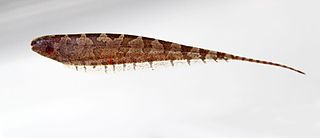
The Hypopomidae are a family of fishes in the order Gymnotiformes known as the bluntnose knifefish. They may also be called grass or leaf knifefishes. These electric fish are not often eaten, of little commercial importance, rarely kept as aquarium fish, and poorly studied; however, species in this family may constitute a significant fraction of the biomass in the areas they inhabit.
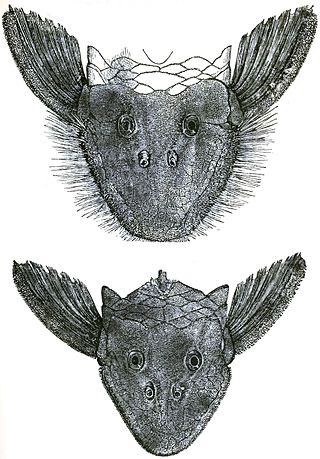
Pseudancistrus is a genus of suckermouth armored catfishes native to South America.

The banded knifefish is a species of gymniform knifefish native to a wide range of freshwater habitats in South America. It is the most widespread species of Gymnotus, but it has frequently been confused with several relatives, including some found outside its range like the Central America G. maculosus. The English name "banded knifefish" is sometimes used for the entire genus Gymnotus instead of only the species G. carapo.
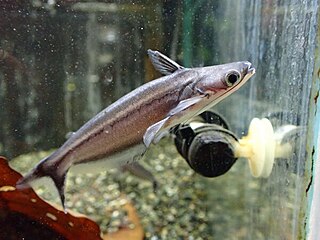
Auchenipterus is a genus of driftwood catfishes.
Sternarchogiton is a genus of weakly electric knifefish in the family Apteronotidae, with five known species, all living in the main channel of large rivers in the Amazon and Orinoco basins in South America.
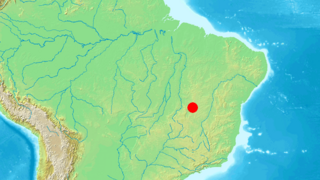
Eigenmannia vicentespelaea is a species of weakly electric knifefish in the family Sternopygidae. Native to the São Domingos karst area in central Brazil, it is the only known knifefish to exclusively inhabit caves. Measuring up to 21 cm (8.3 in) long, E. vicentespelaea can be distinguished from its relatives by its translucent body and reduced or absent eyes. As some individuals retain well-developed eyes, this fish may have colonized caves only recently in evolutionary time.

Apteronotus is a genus of weakly electric knifefish in the family Apteronotidae, distinguished by the presence of a tiny tail fin. This genus is restricted to tropical and subtropical South America and Panama where found in a wide range of freshwater habitats. They feed on small animals.

Adontosternarchus is a genus of ghost knifefishes found in Amazon and Orinoco river basins in tropical South America. They have blunt snouts, a dark-spotted or -mottled pattern on a pale background and reach up to 18.5–32.2 cm (7.3–12.7 in) in total length. They feed on zooplankton and can be found quite deep, with A. devenanzii recorded down to 84 m (276 ft).
Parapteronotus hasemani, the duckbill knifefish, is a species of ghost knifefish found in main river channels and along the margins in the Amazon basin of Brazil and Peru. It is the only member of the genus Parapteronotus. This dark-colored knifefish reaches up to about 38 cm (15 in) in total length.
Platyurosternarchus is a genus of ghost knifefishes found in the Amazon, Orinoco and Essequibo river basins in tropical South America. They are medium-sized knifefish that reach up to 41.5 cm (16.3 in) in total length and have a relatively long, downwards-pointed tubular snout. They are typically found in streams or near the shore of rivers, often among submerged tree trunks and branches over a leaf-covered bottom where they find their invertebrate prey.
Sternarchella, the bulldog knifefish, is a genus of ghost knifefishes found at depths of 2–50 m (7–164 ft) in the main channel of large rivers in South America. Most are from the Amazon basin, but S. orthos is found both in the Amazon and Orinoco, S. orinoco is restricted to the Orinoco and S. curvioperculata restricted to the upper Paraná basin. They are often common in their habitat.
Hypopygus is a genus of South American gymnotiform knifefishes native to the Amazon, Orinoco and upper Paraguay basins, as well as rivers in the Guianas. They are often common, and found near submerged roots, aquatic vegetation and leaf-litter in streams, edges of rivers and floodplains. They are regularly found among vegetation in floating meadows, a habitat that often contains little oxygen, but they are well-adapted to this.
Microsternarchus is a genus of bluntnose knifefish that is found in creeks and streams, often in areas with submerged vegetation, roots and leaf litter, in the Amazon, Orinoco, Essequibo–Rupununi and Río de la Plata basins in South America. The two recognized species are both small knifefish, with the largest being M. bilineatus at up to 12 cm (4.7 in) in total length. The other is M. brevis, which at up to only 5.3 cm (2.1 in) is the world's smallest knifefish. Microsternarchus are very similar to Brachyhypopomus.

Steatogenys is a genus of gymnotiform knifefishes found in the Amazon, Orinoco and Essequibo river basins in tropical South America. The widespread and common S. elegans is found in a wide range of habitats, from the shallow essentially static waters such as floodplain lakes to fast-flowing rivers as deep as 50 m (160 ft). The two remaining species are less common and widespread, with A. duidae found mainly in small streams running through terra firme forests and S. ocellatus among submerged roots and branches in static or slow-flowing blackwater habitats. All three are regularly found among vegetation in floating meadows, a habitat that often contains little oxygen, but they are well-adapted to this.
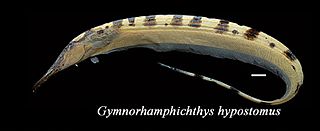
Gymnorhamphichthys is a genus of South American sand knifefishes found in the Amazon, Araguaia, Orinoco and Río de la Plata basins, as well as rivers in the Guianas. They inhabit both small streams and large rivers, but usually over a sandy bottom. During the night they swim head-down over the sandy bottom to locate small invertebrate prey like insect larvae and during the day they rest buried under the sand.

Eigenmannia is a genus of fish in the family Sternopygidae native to tropical and subtropical South America, and Panama. They are typically found in slow-flowing streams, along the edge of large rivers, in deep river channels and in floodplains, and the genus also includes E. vicentespelaea, the only cave-adapted knifefish. Eigenmannia are often found near submerged roots, aquatic plants and floating meadows.
Distocyclus conirostris is a species of glass knifefishes found in the deep waters of the Amazon basin, lower portions of the Potaro River and in major parts of the Rio Orinoco. They are typically relegated to flood basins, flooded forests and main river channels. They have often been found gathering in small groups around vegetation, indicating a social nature. The fish has semi-translucent, glass-like pectoral and anal fins. The main body is a ground-like color with a lighter head. The largest currently recorded specimen is 34.5 cm.
Archolaemus luciae is a species of glass knifefish endemic to Brazil where it is found in the Rio Jari, the Rio Trombetas and the Rio Tapajós basins in the eastern Amazon. Also found in the Rio Araguari. This species reaches a length of 49.7 cm (19.6 in).












